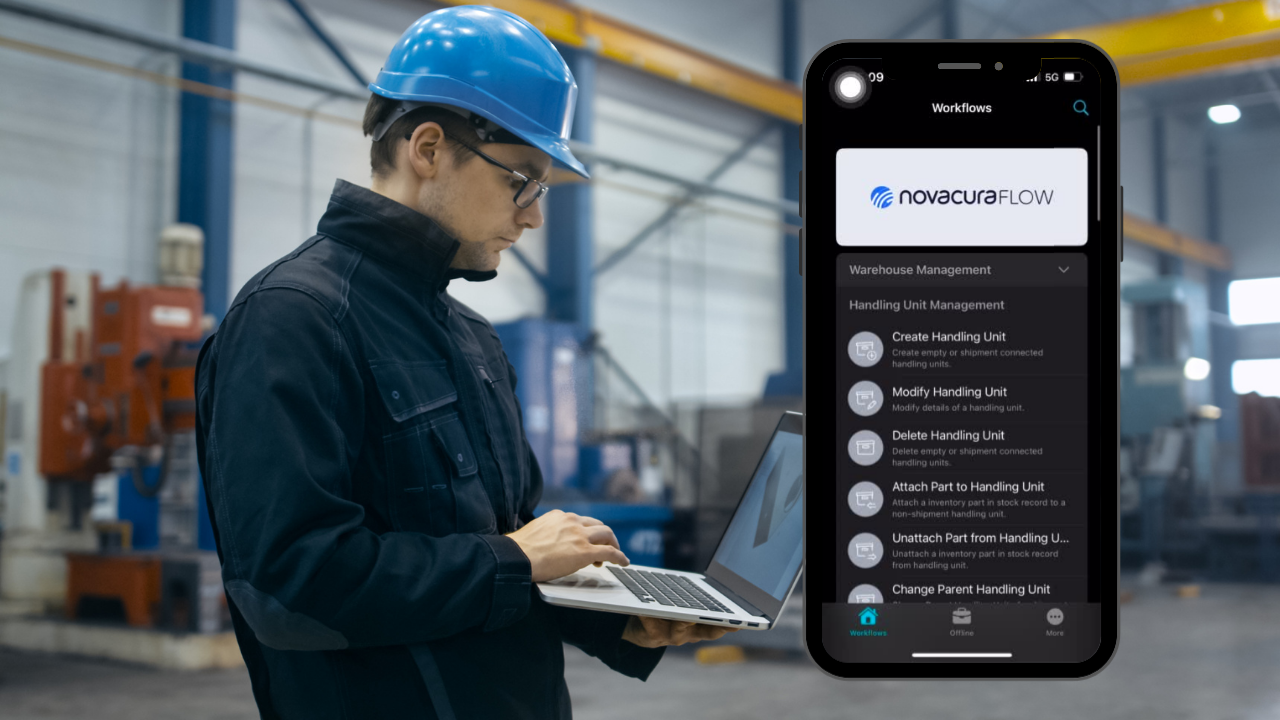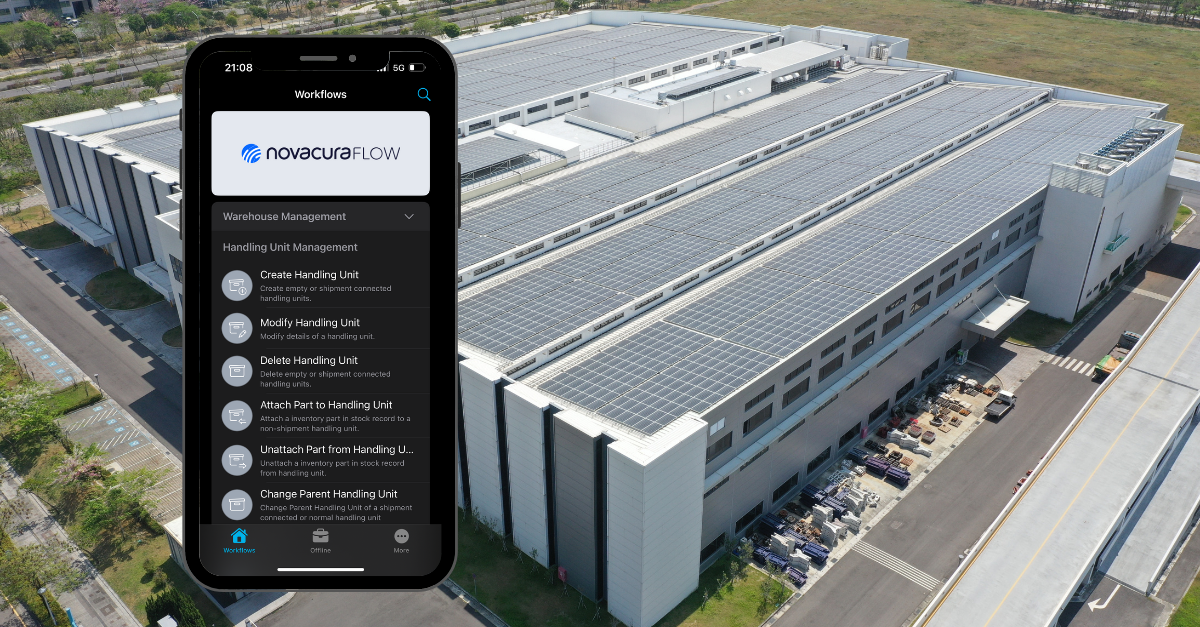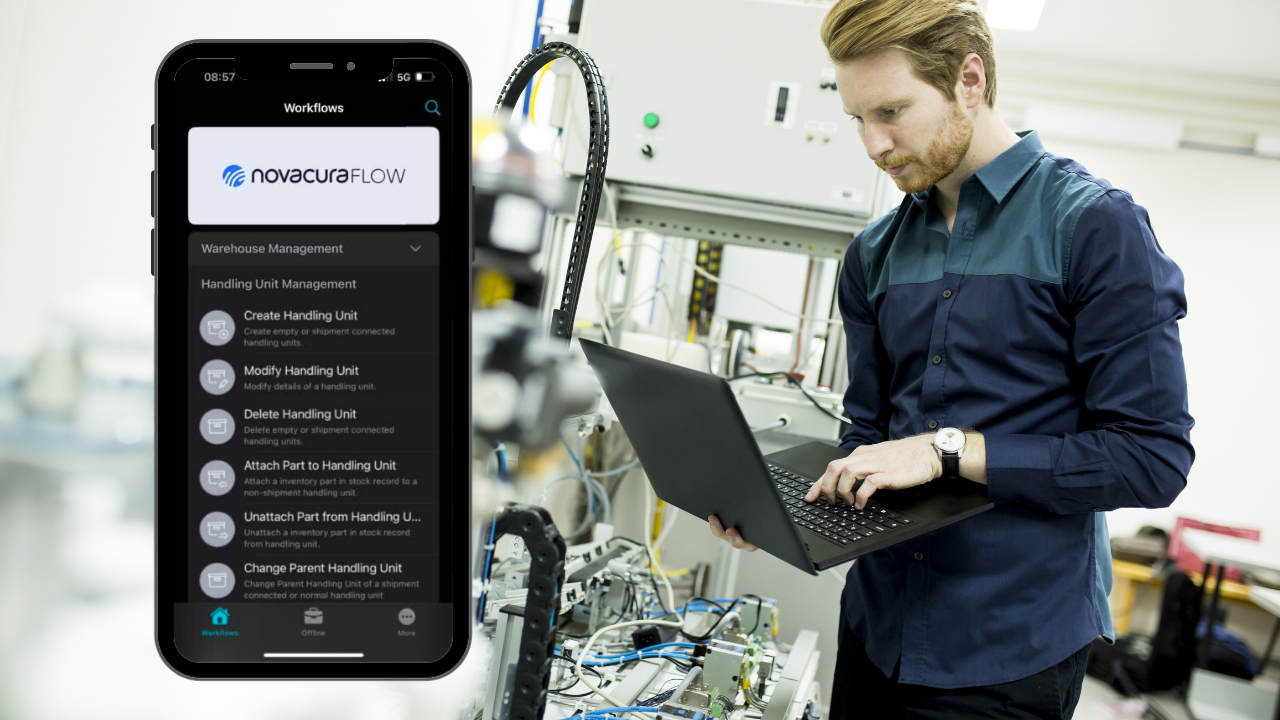Author's Bio
Roel Veenman serves as Lead Business Solution Consultant at Novacura, bringing a deep understanding of how technology, business processes and human factors intersect to deliver effective enterprise solutions. With a strong background in business‐solution architecture and ERP consulting, he has supported organisations in defining solution roadmaps, improving user experiences, and ensuring that platform investments translate into operational improvements.
At Novacura, Roel works closely with both business and IT stakeholders, steering complex initiatives that harmonise strategic objectives with practical execution. His focus is on building scalable, user-centric systems that enable organisations to work smarter, faster and more efficiently.
Publications
:

It is crucial for today’s warehouses, which are adjacent to a manufacturing facility, to meet customer expectations regarding high product quality and efficient distribution. If a company is considering potential cost-reduction strategies, a WMS is the most appropriate solution and can affect all operating expenses in the long term. Since many companies today look at warehousing costs as a percentage of sales or production costs, a WMS is a way to reduce overall warehousing and production costs. We have outlined a key framework on how to overcome bidding hurdles when contracting WMS software, which can minimize uncertainty among manufacturing and warehousing companies. WMS implementation costs Companies looking to implement a WMS must consider several elements and involve costs essential for a successful project launch. Audit fees – are required to prepare an entire business needs assessment to estimate the scope of further implementation. In many cases, companies that do not have in-house resources can use third-party consulting companies for WMS scope evaluation, which generates potential costs at the beginning of the implementation process. In some exceptions, third-party software companies can offer free on-site installed demos with consultancy; manufacturing companies can test software solutions before implementation. Information technology costs – WMS software can include several licenses as cost-per-user, which is a very affordable solution because the company can keep up with sustained growth and increase the supply of user licenses with increased operational demand. The IT costs include integration costs per system user and connector solutions for ERP systems, printer software, IoT connectors to manufacturing machines and robots, etc. Other costs are related to the environment, including development, testing phase, and production as user integration solutions. Nowadays, WMS software is offered in the SaaS model; therefore, companies must cover hosting Cloud costs or On-Premise maintenance, but these costs may instantly cover customer service support. Hardware costs – handheld barcode scanners are essential for seamless WMS operations, allowing employees to work remotely with other useful functions. This is the necessary equipment needed for any WMS to perform optimally. Final equipment needs are determined by internal requirements and can vary, but instead of purchasing equipment directly, a manufacturing company can use equipment leasing/rental, which provides a temporary business depreciation and lowers implementation costs. Indirect labor costs – supervision of the project by in-house personnel such as administrators, quality controllers, and procurement staff, including hours worked and wages with additional fees, which are assigned to the project by the company. These costs arise from collaboration between internal teams and third-party personnel from software vendors. Direct labor costs – on-site implementation of the project with support from a third-party software provider, including working hours booked for business consulting and support software developers. Labor hours relate to the development of the system environment, testing phases, and time required for the final production environment. Training costs – personnel training costs are generated while WMS is ready to Go-Live phase. In this case, the process is connected to overhanging manuals and explanation functionalities to operations staff. WMS software should provide maximum flexibility and easy to follow interface for mobile applications for […]
learn more

Efficiency in the warehouse relies on the proper functioning of an ERP system. Material handling and warehousing systems are crucial for expanding operational capacity and meeting the rigorous standards of global economies. Businesses should exercise caution when choosing an ERP system, considering key indicators in their final decision. The best ERP system should offer a warehouse information exchange system that ensures a seamless flow of data, simplifying information collection, processing, and presentation to users. Equally important is how the system handles decision-making and processes. One of the market leaders in ERP systems is IFS, which provides essential core business functions capable of integrating all departments. IFS demonstrates heightened efficiency when paired with WMS functions within the ERP system. The primary benefits of augmenting ERP with WMS include: Labor: Minimizing manual operations through mobile solutions and enhanced staff management, offering a holistic view and control over productivity. Inventory and Inventory Costs: Reducing inventory discrepancies by improving manual operations related to allocation units, relocations, shipping, cycle counting, storage, and more. IFS WMS The most common approach to building a business case for a WMS involves evaluating a company’s current and future requirements. This assessment helps companies determine which WMS solutions are best suited for their warehouse operations. There are three primary types of system solutions that offer WMS functionality: Off-the-shelf (COTS) software: This type of software consists of pre-packaged, commercially available solutions designed to handle standard warehouse operations, such as receiving, a limited range of storage options, and shipping. These solutions typically offer no room for customization, and many tasks still need to be carried out manually. Enterprise resource planning (ERP) software: ERP software integrates various departments within an organization and often includes specific ERP components tailored to meet operational needs. These components are selected to cover the functionalities provided by COTS-WMS software. Custom-developed software: This software is custom-built to address specific operational requirements. It often includes tailored customizations to extend its functionality. However, subsequent upgrades can be costly and time-consuming, frequently requiring support from external programmers. Standard Commercial Off-The-Shelf (COTS) software often falls short in providing extended functionality. Although ERP systems are pivotal in warehouse operations, they may encounter limitations in delivering comprehensive support for the evolving and dynamic needs of a growing business. Conversely, custom-built software might lack the capacity to address unforeseen warehouse challenges that may arise in the future. Each of these options comes with its own set of strengths and weaknesses, underscoring the importance for companies to carefully select the most suitable solution based on their unique operational requirements. The cornerstone of the WMS software designed for IFS was predominantly WADACO, a solution enabling the integration of custom functions as an additional layer to an ERP system. However, numerous international warehouses chose to swiftly enhance their mobile capabilities within operations, presenting a considerable challenge. The task became particularly daunting as constructing a business case for a WMS primarily involved quantifying the financial advantages of digitizing the system. While companies could pinpoint various financial expenses upon assessing their warehouse needs, they found themselves in need of assistance to evaluate the […]
learn more

Modern companies in various industries depend on warehouse management; therefore, this part of the business should be monitored for performance to eliminate potential inventory problems even before they occur. The best practice to avoid inventory issues is to digitize internal processes with the software capabilities of a barcode scanning system for a warehouse. It is crucial to know that the software that manages the barcode system controls the complete data flow process and is responsible for the success or failure of current operations. While maintaining the best practices for barcode warehouse management system implementation, it is crucial to understand the technology behind the solution. A well-functioning WMS software can fully support the barcode implementation in the warehouse, allow for the reduction of inventory discrepancies and data backlogs resulting from insufficient data management, and enable high accuracy in ongoing business operations. Warehouse barcode system and its technology What is a barcode? Barcodes are visual representations of data, typically a sequence of numbers and/or characters, encoded into a pattern of lines, spaces, or squares. The data in barcodes is based on references containing descriptive information. Barcodes do not have any item details; it is just a number that allows data retrieval from or transmission to an ERP system or a similar database. Reading barcodes is only a data entry method, but it is nevertheless a very efficient system compared to paper-based and repetitive manual registration in an ERP system. Barcode technology consists of four elements that allow the classification of objects in a warehouse: Symbol System: Optical codification of an object’s reference number, commonly known as a barcode or QR code, which consists of coded information based on Code 39, Code 128, Interleaved 2 of 5 (used by airlines), UPC (Uniform Product Code), EAN (European Article Numbering). Printers: Label devices with readable symbols dedicated to mobile devices’ RFID or image reading capabilities. Mobile Devices: Scanners, tablets, cell phones, or other decoders with the capability of capturing images of symbols and converting them into digital information transmitted to ERP via WMS software. Verification and Validation System: A system that assists in recognizing the compliance of each barcode for an asset, helping maintain the quality of the information system. Warehouse scanning systems – the barcode descriptive information Vertical lines shape the barcode image with spaces; in the case of QR codes, it is a composition of quadrants enclosed in a square image. After the barcode data is scanned and loaded into the mobile device, the descriptive information is transmitted to the WMS by radio frequency. The symbols are decoded and converted into typed characters that can be further transmitted to the ERP system. Barcode images can carry and pull ERP data to scanners with descriptive information as it follows: LOT, SKU, part number: base information about the object on the location. Quantity (QTY): the required number of items stored on the location. Supplier identification (ID): information about the origin of the object. Serial Number (SN): contains more detailed data distinguishing items in the return cycle. Expiry date: contains data defining the product’s life and the inventory’s aging. Production data: […]
learn more

What is a WMS (Warehouse Management System)? A Warehouse Management System (WMS) is a software platform designed to give businesses comprehensive control over their warehouse operations. It serves as a centralized system that helps manage inventory, streamline order fulfillment, and monitor warehouse activities in real-time. WMSs include a variety of functions designed to support more advanced warehouse operations. These cover such tasks as receiving/unloading, inspection, inventory control, storage, packing, and shipping/loading. To keep better control over ongoing operations, WMS should reduce this complexity, integrate different technologies, and ensure that the solutions are compatible with existing systems and are returnable in terms of improved performance. WMS software can be connected as a separate module to the ERP system, giving extra operability to the warehouse with new systems transactions that are missing in ERP. Understanding how to select the best Warehouse Management System is crucial for optimizing warehouse performance and ensuring seamless integration with existing business processes. Why Choosing the Right Warehouse Management System Software is Important? Selecting the right Warehouse Management System (WMS) software is a crucial step for ensuring business success. A well-chosen WMS provides advantages that directly impact operational efficiency and overall profitability: Cost Savings: Through workflow automation, reduced manual labor, and minimizing errors, a WMS can significantly cut operational expenses while optimizing daily tasks. Improved Customer Satisfaction: Faster order processing and accurate inventory management enhance customer experience, ensuring timely deliveries and reducing the risk of stockouts or miscommunications. Scalability: A reliable WMS should evolve with your business, supporting increased inventory volumes, additional locations, and more users as your operations expand. What to look for in warehouse management system software? Looking through the personnel and task allocation clearly shows that intelligent redistribution of roles in different departments is key to keeping efficient business operability. Personnel activities should be aligned with equipment and inventory management requirements. Here are the tips that are important for procurement and help estimate what to look for and what to consider when choosing a WMS: Inventory management system — warehouse should have a clear overview regarding size, design, and desired physical movement and allocations of products with inventory transactions. Whether it comes to medical goods, the clerk should know that they may keep medical or dangerous goods out of the fridge only within a restricted time frame until it will not be loaded onto trucks with cooling. Product life cycle as FMCG or racking system, what goods can be placed next to one another and how to pick orders fastest should be an accessible solution from the WMS system. Maintenance system — machines and equipment require constant maintenance to prevent machine malfunctions and downtime in production as well as avoid delays with shipments or unloading consignments once EPT or forklift is out of order. Control over maintenance is required to eliminate losing goods to damage caused in the broken fridge when the company is storing FMCG. WMS should have features that allow keeping control over equipment conditions. Tasks and roles redistribution system — diversity of operations required a clear system for task management and the ability to smooth switching […]
learn more

The purpose of this article is to present the most important functionalities and components of the Warehouse Management System (WMS). It will also highlight the advantages of having such a system and its applications. An essential functionality of WMS is the ability to recognize ongoing business activities in the warehouse, which significantly impacts revenue generation and is critical to the productivity of any company that utilizes warehouses. The company should be aware of which Warehouse Management System (WMS) software functions have the greatest effect on efficiency. To implement WMS effectively, various technical aspects need to be considered, such as the scope of daily activities, the level of staff involvement required, inventory lifecycle costs, and supply chain coordination. Warehouse managers will have to address many strategic questions regarding the scope of WMS software. This should lead to the implementation of the most suitable solution dedicated to warehouse operations, regardless of industry or integration with a distribution or manufacturing facility. WMS functions are closely linked to the internal processes of any company utilizing a warehouse. What is a Warehouse Management System? A Warehouse Management System (WMS) is a specialized platform (software) that optimizes warehouse operations by centralizing and streamlining inventory management and the processes that apply within them. WMS is designed to handle the day-to-day activities of a warehouse. The WMS system helps coordinate inventory tracking, task allocation for employees, and goods relocation within the warehouse environment. Modern WMS platforms, often referred to as warehouse management software, encompass a wide range of functions that support key warehouse activities, such as order fulfillment, inventory control, and workforce management. The tools that make up such a platform are essential for warehouse managers, helping them streamline task execution, improve work accuracy, and quickly respond to operational needs. Using WMS aims to increase efficiency and productivity, allowing warehouse teams to better meet customer expectations and maintain the company’s competitive position in the market. By implementing a WMS system, companies gain the flexibility and control needed to adapt to changing market demands and operational requirements. Key elements of the WMS system The technical aspects of the warehouse management system functions are based on three key elements: Software: This is a digital system that operates on the basis of ERP data exchange, allowing the ERP to be extended with an additional transaction and providing remote control via dedicated applications for mobile and desktop devices. Radio Communication Devices: Mobile devices throughout the warehouse require a wireless network system for communication between servers and the ERP system. Barcode System: The WMS software operates using RFID scanners with a barcode/QR reading function. This is the fundamental element of data collection, and all handling unit operations rely on it to provide continuous data to the system. Key features of the warehouse management system In order to properly select a Warehouse Management System, it is necessary to determine the criteria it must meet. Key areas that require digitization should be mapped out. The WMS should have the functions and capabilities to manage these areas. These include: 1. Handling units system Receiving: Recording incoming goods in […]
learn more

In the logistics and transport industry, demand and supply are changing rapidly due to the network dynamics in which companies are interconnected, resulting in a rapid pace of innovation and the introduction of new products and services. The individual situation in which a company finds itself will determine the direction of business development. The highest breakthrough points are often on the line when a company wants to increase its sales. The company will then provide a budget for market research and development. It will be important for software companies that work in logistics and transport to develop a highly personalized product that can meet current business needs. For transport and logistics companies, it will be important to provide a high-quality service at the lowest possible price. During the event, some of the companies presented an autonomous truck with a mobile tracking system. International Exhibition for Logistics in Munich 2023 Novacura visited the Transport Logistics 2023, the International Exhibition for Logistics, Mobility, IT, and Supply Chain Management, from 9-12 May 2023 at the Messe München Trade Fair Centre in Munich, Germany. Fairtrade events have common characteristics that allow companies to introduce innovation and a learning perspective, as well as an internal business perspective. Such views integrate different approaches that influence market and business development. Transport and logistics focus on operations where business processes remain the same. However, there will be a significant need for continuous improvement when it comes to mobility, IT, and supply chain management, which partly shape logistics and transport operations. This is due to the prospect of increasing competition in the market and narrowing revenue margins caused by the ever-reducing cost of services. Logistics and transport companies have embarked on large-scale development to remain competitive through innovation, which leads to maintaining low business costs in the long term. Mobility and IT services played a leading role During the event, we could observe innovations in technology and business management, where mobility and IT services played a leading role. We were able to observe innovations in these areas: Mobility and business software providers – software providers focus on corporate objectives, including business units, functional business areas, and supply chain strategies, which are the common game plan for logistics and transport. Therefore, software companies provide mobile applications as the absolute standard in logistics, providing companies with the ultimate benefit of TMS and WMS. Today’s software development trend in logistics and transport is linked to component supply chain integrators, synchronizing customer demand with other components and supply systems to provide the basis for operational decisions and set the boundaries of available strategic options. Among the proposals for sea freight, exhibitors presented IoT solutions for tracking container shipments. Such a solution can be supported by a B2B portals, offered by Novacura, which allows shipments to be tracked between carriers, whether by ground, air or sea freight. Technology – innovation in range availability in building products that are safer and easier to use in logistics and transportation. Companies providing pharmaceutical and healthcare products, services, and solutions are now more innovative and providing a more cost-effective service as, in […]
learn more

